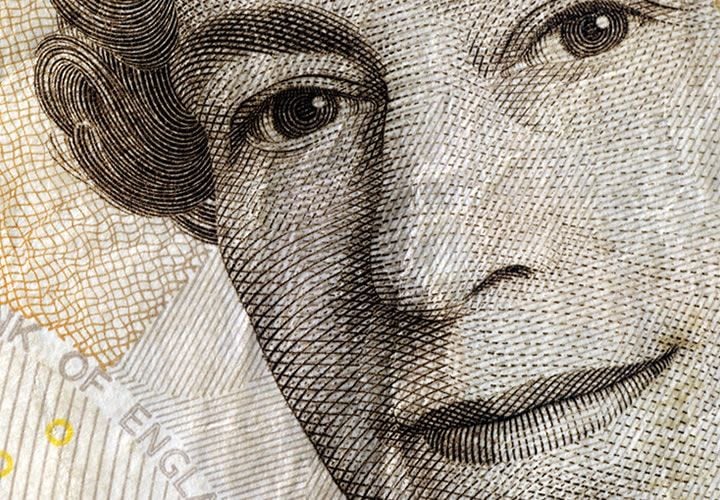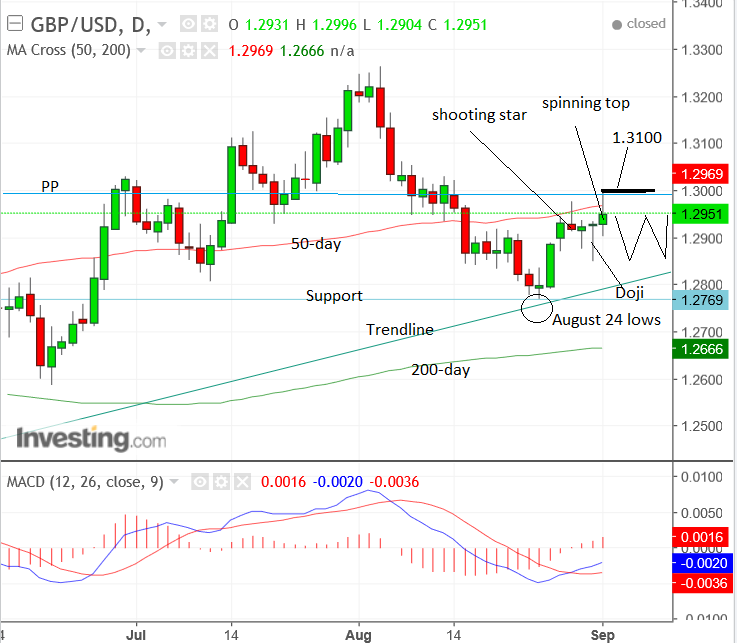5-Day Pound / Dollar Exchange Rate Technical Forecast, News and Events Over the Next Five Days

The Pound to Dollar exchange rate has risen up to the 50-day moving average at 1.2969 and then pulled back under heavy selling pressure into Friday's close after the Dollar made a strong comeback after the release of August Payrolls.
The GBP/USD recovery, which began at the August 24 lows, is in jeopardy and there is a possibility of the pair moving sideways or possibly lower.
The trendline at the August 24 lows stands in the way of more downside, however, as does the support line at 1.2769, which is at the level of old highs.
In technical analysis former highs can become support levels in the future if surpassed, acting as obstacles to further downside, when previously they were obstacles to upside.
The monthly pivot at 1.2990 is also likely to act as a ceiling capping further gains.

Monthly pivots are used by traders to gauge and oftentimes fade the dominant trend since the exchange rate often bounces or pull's back from them.
Therefore, for confirmation of more upside, we would ideally wish to see the exchange rate clearly break above 1.3020, with a target thereafter at 1.3100.
Overall, however, we are not convinced the market will necessarily move strongly in either direction, given the string of uncertain and volatile days in the previous week.
This was especially reflected in the spinning top candlestick pattern which formed on Friday and the alternating shooting star and hammer/doji candlesticks which formed earlier in the week.
Get up to 5% more foreign exchange by using a specialist provider by getting closer to the real market rate and avoid the gaping spreads charged by your bank for international payments. Learn more here.
News, Data, and Events to Watch for the US Dollar
The Dollar ended the week on a high after the release of Non-Farm Payrolls, despite the lacklustre result.
The main event in the week ahead will probably be related to political machinations surrounding the US debt ceiling, although in the aftermath of Hurricane Harvey we expect it to be raised, given the new infrastructure required in the devastated area.
As far as hard data goes, there is nothing out on Monday as it is Labor Day, a public holiday in the US.
On Tuesday, Factory Orders are out at 15.00 BST and expected to show a -3.2% fall in July.
Wednesday sees the release of ISM Non-Manufacturing PMI in January, which is forecast to come out at 55.3 from 53.9.
Services PMI is out at 14.45 and is forecast to show a slight retreat from 56.9 to 56.8 in August.
The Fed's Beige Book, which is an account of all the provincial Fed's economic performance is out at 19.00.
Thursday, September 7, sees the release of Initial Jobless Claims, which are forecast to rise to 241k.
Also, watch out for Fed speakers and the hot topic of whether there is likely to be another rate hike before the end of the year or not.
In relation to Fed speakers in the coming week, Canadian investment bank TD Securities have said the following:
"Attention should focus on Governor Brainard on Tuesday morning and NY President Dudley on Thursday evening. Brainard is likely to repeat earlier dovish remarks on inflation, while Dudley may hawkishly suggest easy financial conditions warrant additional rate hikes. The four remaining speakers span the hawk-dove spectrum."
Data to Watch for the Pound
On Monday, Construction PMI for August is out at 9.30 BST, and on Tuesday Services PMI at the same time.
PMI's are surveys of purchasing managers and provide a snapshot of how conditions are in a particular industry sector.
A score of over 50 indicates expansion and under 50 indicates contraction. The manucaturing PMI numbers, out on Friday 1 September, showed activity in the sector had reached a three-year high which suggests economic activity is lifting into year-end.
Much of Sterling's recent weakness owes itself to a run of softer-than-anticipated numbers; this week's data will be key in assessing whether the economy is in fact picking up pace.
Construction is forecast to come out at 52.0 in August from 51.9 in July, and Services at 53.5 from 53.8 in July.
Thursday, September 7 witnesses the release of Halifax House prices in August at 8.30 BST.
Friday, September 8, sees the release of Industrial and Manufacturing Production for July, at 9.30 BST.
The former is supposed to show a 0.2% rise and the latter a 0.3% rise.
The Trade Balance in July is out at the same time, and is expected to show a narrowing of the deficit to -11.9bn from -12.72bn previously.
Politics: E.U. to Make an Example of the U.K.

Image (C) European Commission.
While the data calendar hots up over coming days, politics will never be far away as a driver of Sterling.
Concerning headlines over the weekend have confirmed what many in the U.K. fear: the E.U. intends to make an example of the U.K. for its decision to exit the E.U. with chief negotiator Michel Barnier stating negotiations offer an opportunity for the E.U. to "teach the British people and others what leaving the EU means".
Barnier told a conference in Italy on the weekend that while he did not want to punish the U.K. for leaving he did confirm Brexit would serve as an "an educational process" for the British.
"I have a state of mind - not aggressive... but I'm not naïve," Barnier told the Ambrosetti forum. "There are extremely serious consequences of leaving the single market and it hasn't been explained to the British people. We intend to teach people… what leaving the single market means."
This confirms our view that the E.U. are in fact not in the mood for negotiating; rather they are placing a prescribed set of conditions down before the U.K. which must be accepted, or no deal will be granted.
Brexit negotiations have now passed three rounds, with some progress being made but the E.U. are keen to make it known that none of their initial objectives - particularly on receiving a payment of ~€100BN from the U.K. on its exit from the Union have yet been agreed.
Until the E.U. greenlight the first rounds concerning the technicalities of exit, they are not willing to discuss trade. This leaves Sterling prone to the risk that a disorderly exit takes place.
The big question we are however asking is whether or not Sterling fully reflects such a disorderly Brexit. If it does, then presumably the currency will become increasingly immune to negative newsflow concerning the negotiations. If not, then substantive downside must be negotiated.
Another question to ask, from a currency perspective, is how will dynamics change were the E.U. to be exposed as simply seeking to punish Britain, how does this impact on internal E.U. politics, particularly for countries such as Ireland and the Netherlands which rely heavily on their exports to the U.K?
German manufacturers also rely heavily on the U.K. market and one would expect a clash of economic interests and the political ideology as pushed by Barnier, Juncker and Verhofstadt.
Can pragmatism push the E.U. into a friendlier approach? If the answer is yes, it would certainly benefit Sterling.
Another question for those trying to anticipate the direction of politics and Sterling is to consider whether comments of "educating" the British sit well with the British people?
We saw how Theresa May found a rise in support on her robust response to Jean-Claude Juncker after he labelled her a difficult woman following a dinner in Downing Street. Voters tend to respond well to those defending them, and this might be the case should a seige mentality be established on the back of a daily barrage of warnings and threats from the E.U.
We would suggest that the Government's position on Brexit, and the Conservative Party by extension, might find some support were they to be seen as standing up to the E.U. and having a more flexible approach to negotiations.
And a more secure hand for the Conservative Party would play well for Sterling as a fragile Government makes for uncertainty, and the Pound hates uncertainty.
The prospect of five years without another uncertainty-inspiring vote will be welcomed.




